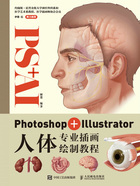
序
医学插画和其他学科一样,也在不断发展。这种发展主要源于以下因素:医学插画受众范围的扩大;医学技术的快速发展;用于制作医学插画的技术发生了爆炸性的进步;以及对有效视觉传达原则的理解。
医学插画的受众范围已经扩大。在20世纪的大部分时期,医学视觉传媒的设计主要是为了满足医护人员和医学生的需求,协助他们学习新技术以及相互交流成果。今天,这些群体仍然重要,但我们也已经意识到医疗服务的接受者——病人——同样会从这种教育中受益:了解医疗服务是如何进行的,他们的身体是如何构造的,各类疾病如何影响他们,以及现代医学是如何治疗这些疾病的。
我们也看到了需要视觉传达的领域不断扩展。例如,我们对分子世界有了更深层的认知,了解了分子与人体健康的关系,这促使医学插画师扩大他们所描绘的范围。
近年来,技术革新瞬息万变。就在25年前,医学视觉传播媒体的创建还主要是通过非数码工具来实现的。最复杂的渲染也是在物理媒介上制作的,如插画板和喷绘笔。医学课上,老师仍然会在投影仪的帮助下,通过切换专门制作的幻灯片讲课。今天,大多数医学插画是由各种不断变化的先进数字工具进行传播的。现代医学插画师必须跟上这些变化,并不断接受这些变化,学习新的工具和使用这些工具制作图像所需的技术。
一名医学插画师要想成功,需要跟上行业快速发展的步伐,包括医学科学和绘图技术的发展。然而,许多新进入该领域的人往往忽略了第三种,也是医学插画师三大核心能力之一——理解视觉传达的原则并且用它们来有效地传达信息。
这些视觉传达的原则往往是非正式制定、验证和分享的。也是直到最近,才通过心理学、教育学等学术领域用正式的证据验证了这些发现。这也给从业者提供了新的机会,以此为基础进行设计上的思考。了解如何设计插画,以便有效和高效地引导读者完成一系列的步骤,也许要比绘图技巧更重要。技术是不断变化的,但好的设计理论和视觉传达原则通常是相对稳定的。
如果合理地学习和应用这些原则,你便能受用一生。
姬楚写这本书的目的就是要让大家认识到这些原则,并掌握一些有用的现代医学插画绘图技巧。这本书旨在启发所有对视觉艺术和科学都有兴趣的人,向他们介绍之前可能从未想过的职业道路。医学插画师是个实实在在的工作,需要医学/科学素养、图像制作等方面的综合能力和沟通技巧。这本书是一个涉足此领域的很好的开始,可以让你更好地理解医学插画师的工作以及他们所使用的技巧。
如果你打算从事医学插画师的职业,请从阅读本书开始,并实践其中的技巧。再看看其他书籍、期刊文章和网站上完成的插图,研究插画师的设计选择,尝试确定插画的信息传达目标是什么,插画师是否成功地实现了他们的目标。如果没有,请重新设计插画,并尝试改进它!
如果你打算成为一名专业的医学插画师,这本书是一个有用的开端,但只有你下定决心,并通过学习、分析和应用从这本书中学到的知识,才能获得实现梦想的机会。
对于那些不打算成为医学插画师的人来说,比如科学领域中的研究人员,如果想将插画或图表用于出版论文或演示文稿,这本书仍可作为实用指南,帮助你创造更好的视觉效果。
随着科学和医学信息的数量和复杂性大幅增加,此时比以往任何时候都更需要有相关技能的人,让所有受众都能理解这些信息。
学习这本书,练习其中的技巧,然后应用它们来帮助大家理解世界。
迈克尔·柯林
多伦多大学生物医学可视化专业助理教授
During this period,medical illustration like other disciplines has evolved. This has been driven by a broadening of the audiences medical illustrations are created for; a rapid expansion of medical science; an explosive transition in the technologies used to produce medical illustrations; and an evolving understanding of the principles of effective visual communication. The audiences for whom visual medical illustrations are created for has expanded.
During most of the twentieth century,the design of medical visual communication media was largely for medical and nursing trainees,surgeons learning new techniques and scientists communicating findings with each other. Today,those audiences remain important,but we have also come to realize that the recipients of medical care - the patients - benefit from being educated about how their bodies are constructed,how pathology affects them and how modern medicine approaches repair.
We have also seen new scientific domains in need of visual communication emerge. For example,the rapid development of knowledge about the molecular world and its relationship to human health has led to the need for medical illustrators to widen the range of scales they depict in imagery.
Recently,the pace of technological innovation has been supersonic. Just twenty-five years ago,creating visual communication media for medicine was largely a practice dominated by the use of non-digital tools. The most sophisticated renderings were created on physical media,such as illustration board,with instruments like airbrushes. Medical instructors in the classroom still lectured with the aid of slide projectors that mechanically churned through carousels of photographic slides produced by a chain of experts. Today,most medical illustration is produced and distributed using a wide array of ever-changing,sophisticated digital tools. The modern medical illustrator must remain abreast of these constant shifts and constantly receptive to learning new tools and the techniques required to make imagery with them. While successful practice as a medical illustrator requires that one keep up with the rapid pace of medical science and technology,many new to the field often overlook the third and equally important member of the core triad of competencies: understanding the principles of effective visual communication. These principles were often informally developed,validated and shared by practitioners until more recently when academic disciplines,like educational cognitive psychology,validated those findings with formal evidence and also gave practitioners new evidence on which to base their design choices.
Understanding how to design an illustration so that it effectively and efficiently leads a reader through a sequence of steps is arguably more important than how to use technology. Technology is ever changing but the principles of good design and communication are relatively stable and once those principles are reasonably well understood can serve you for a lifetime.
It is the goal of Nancy Ji's book to acquaint you with those principles,as well as some useful modern medical illustration techniques. This book is intended to inspire all those individuals with a love for both visual art and science by introducing them to what may have been,before now,an unthought-of career path. A medical illustrator is a real job and requires a complex combination of medical/scientific literacy,image-making and communication skills. This book is a good place to start to better understand what medical illustrators do and the techniques they use to do it. If you intend to pursue a career as a medical illustrator,start by reading this book and experimenting with the techniques within it. Look at other books,journal articles and websites with completed illustrations. Study the design choices made by the illustrators. Try to determine what the communication goal of the illustration was and whether the illustrator successfully achieved that goal; if not,redesign the illustration and try to improve it!
If you intend to become a professional medical illustrator,this book is a useful place to begin but only your commitment to analyzing and applying what you have learned from this book will give your dream a chance of becoming a reality.
For those who do not intend to become medical illustration professionals,such as scientific researchers,but want to become better at creating illustrations or diagrams for use in publication or presentations,this book can still serve as a practical guide to help you create better visual communication materials.
With the massive increase in the quantity and complexity of scientific and medical information,more than ever,people with the skills to make that information understandable to all audiences are needed. Consume this book,practice its techniques and then apply them to help everyone make sense of the world.
Michael Corrin
Assistant Professor | Biomedical Communications at the University of Toronto